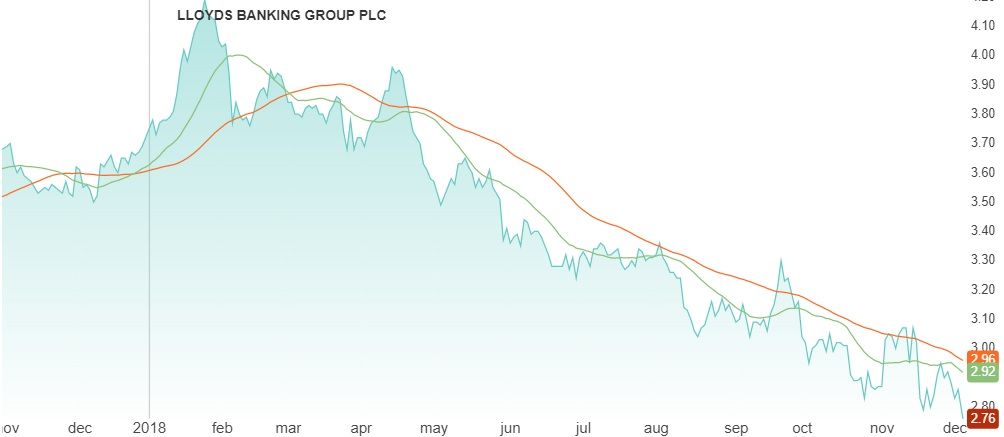As the UK’s largest mortgage lender, Lloyds [LLOY] is facing serious headwinds from a slowdown in the UK property market, as well as the prospect of higher interest rates, ongoing scandals, the unexpected rise in bad loans and, of course, Brexit.
Like most banking stocks in the UK, Lloyds has mainly been on a downtrend, falling 15% since the beginning of 2018 with its shares now worth less than 60p for the first time in nearly two years.

Lloyds share price performance, NASDAQ interactive chart, as at 5 December 2018
Meanwhile, the banking group’s stock has delivered several years of strong profit growth, plus generous dividends. Could this be enough to entice investors in light of the storms ahead?
Alex Wright, fund manager at Fidelity, thinks so. He says that the gloom surrounding the UK stock market could instead see a strong rebound next year, as markets have a way of “confounding expectations and surprising consensus”.
The Bank of England also believes Lloyds is strong enough to withstand a disorderly Brexit, according to its stress tests of the UK banking sector, and says that it could continue to lend in a scenario more severe than the financial crisis.
Strong Q3 earnings result
Despite this downturn in share price, Lloyds stock did see a small spike of 1.8% after announcing its third quarter earnings on 25 October, which showed continued growth in profit and returns.
The better-than-expected results revealed $5 6bn in net income, showing an increase of 2% from last year’s same quarter, and an after-tax profit of $1.6bn, which was also up by 5% compared to the same quarter last year.
Lloyds also reported a significant improvement in returns, as tangible equity was up 1.4 points at 16.2%, while the statutory return was up by 2.5% at 13%. Strong capital generation, with an increase of 41 basis points, sees the stock up 162 basis points year-to-date.
| Net income, Q3 YoY | +2% |
| Performance YTD | -23.1% |
| Market cap | £39.87bn |
| PE Ratio (TTM) | 9.84 |
Lloyds stock vitals, Yahoo finance, as at 5 December 2018
PPI financial scandal costs Lloyds $24.5bn
The UK bank owes its robust business model to CEO António Horta-Osório. “Since taking over the reins in 2011, Horta-Osório has presided over a bank which has swung from an annual loss of £260m to a profit of £3.5bn,” Laith Khalaf, senior advisor at Hargreaves Lansdown, said in August, following the Q2 earnings release.
Although, the share price is roughly the same level it stood at when Horta-Osório became CEO, that’s mainly been due to the uncertainty surrounding Brexit and scandals that have battered investor confidence.
“Since taking over the reins in 2011, Horta-Osório has presided over a bank which has swung from an annual loss of £260m to a profit of £3.5bn,” - Laith Khalaf, senior advisor at Hargreaves Lansdown
The mis-selling of payment protection insurance (PPI), for example, has been the bane of Lloyds stock since it first announced that it would compensate customers in 2011, which in turn ended up exposing the full extent of the scandal that dated back to the 1990s. It has cost the bank $24.5bn to date, and expects 13,000 PPI complaints a week until the claims deadline on 29 August 2019.
Adding to its legal dramas, a trial brought against Lloyds by almost 6,000 former shareholders over its ill-fated takeover of Halifax Bank of Scotland in 2008 has started in the high court.
Digital strategy spurs growth in new areas
Lloyds Bank has made quite a few changes in 2018, particularly in the boardroom, which has seen a bit of movement, with CFO George Culmer announcing retirement plans for the third quarter of 2019 being the most recent.
But its biggest development came in February 2018 when it announced that it would invest more than $3.8bn over the next three years in a new strategic plan, a 40% increase from the previous strategy.
Its investment in robotics is said to have saved over 600,000 hours of employees’ work to date and its private cloud solution is said to be delivering more efficient, scalable and flexible infrastructure.
Like other banks, Lloyds has been reducing the size of its network as customers increasingly make the move to online. In April, it announced the closures of 49 branches as part of that effort.
600,000hours
Employee time saved as a result of Lloyds Bank investment in robotics
In a further step towards Lloyd’s 2020 strategic plan to digitise its operations and grow outside of core markets like mortgages, it has formed the largest ever wealth management alliance with Schroders [SDR] to accelerate its Scottish Widows business.
As two of the UK’s strongest financial services businesses, the £102bn joint venture deal will bolster each other’s digital capabilities and is expected to deliver significant additional growth.
As it stands, despite its significant progress and a 5.7% prospective dividend yield, threats to Lloyds bottom lines caused by the slowing UK economy could turn investors away from the stock. On the other hand, the company’s outlook is only expected to improve. With a forward P/E ratio of 7.24, compared to a trailing ratio of 9.92, the stock may currently be trading at a discount following the dip across the past 10 months.
Disclaimer Past performance is not a reliable indicator of future results.
CMC Markets is an execution-only service provider. The material (whether or not it states any opinions) is for general information purposes only, and does not take into account your personal circumstances or objectives. Nothing in this material is (or should be considered to be) financial, investment or other advice on which reliance should be placed. No opinion given in the material constitutes a recommendation by CMC Markets or the author that any particular investment, security, transaction or investment strategy is suitable for any specific person.
The material has not been prepared in accordance with legal requirements designed to promote the independence of investment research. Although we are not specifically prevented from dealing before providing this material, we do not seek to take advantage of the material prior to its dissemination.
CMC Markets does not endorse or offer opinion on the trading strategies used by the author. Their trading strategies do not guarantee any return and CMC Markets shall not be held responsible for any loss that you may incur, either directly or indirectly, arising from any investment based on any information contained herein.
*Tax treatment depends on individual circumstances and can change or may differ in a jurisdiction other than the UK.
Continue reading for FREE
- Includes free newsletter updates, unsubscribe anytime. Privacy policy





